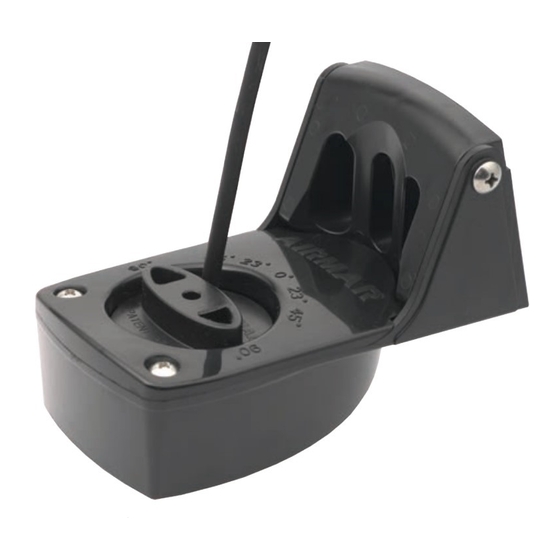Advertisement
OWNER'S GUIDE
Transom
or Optional
CHIRP or Adjustable Wide-beam Transducer
Models: P48W, TM150M
U.S. Patents 7,369,458; 7,961,522; 8,582,393. UK 2 414 077
Follow the precautions below for optimal
product performance and to reduce the risk of
property damage, personal injury, and/or death.
WARNING: Always wear safety glasses, a dust mask,
and ear protection when installing.
WARNING: When the boat is placed in the water,
immediately check for leaks around the screws and
any other holes drilled in the hull.
CAUTION: P48W—Operate at 200kHz only.
Operating at any other frequency will permanently
damage the transducer and/or the echosounder.
CAUTION: TM150M CHIRP transducer—Always
operate the transducer in water. Operating in air will
allow the transducer to overheat resulting in failure.
CAUTION: The bracket protects the sensor from
frontal impact only.
CAUTION: Never pull, carry, or hold the transducer by
its cable; this may sever internal connections.
CAUTION: Never strike the transducer with anything
except the palm of the hand to release it.
CAUTION: Never use solvents. Cleaner, fuel, sealant,
paint and other products may contain solvents that can
damage plastic parts, especially the transducer's face.
IMPORTANT: Read the instructions completely
before proceeding with the installation. These
instructions supersede any other instructions in your
instrument manual if they differ.
Applications
• Recommended for boat up to 7m (22') long
• Not recommended for boats with large inboard engine(s)
• P48W—Not recommended for stepped transoms because the
transducer will be difficult to adjust.
• Vertically orients sound beam on hull with deadrise angle up to 22°
• Adjusts to transom angles from 2
• Requires 89mm (3-1/2") of headroom to install
• Release bracket protects sensor from frontal impact only
• P48W—Trolling Motor Kit adapts transducer for use with a
trolling motor or optional Portable Bracket
Trolling-motor Mount
°
°
– 22
&
INSTALLATION INSTRUCTIONS
Record the information found on the cable tag for future reference.
Part No._________________Date___________Frequency________kHz
Tools & Materials
Safety glasses
Dust mask
Ear protection
Phillips screwdrivers
Pencil
Electric drill
Drill bits:
Bracket holes
Transom hole (optional)
Cable clamp holes
Masking tape
Angle finder (some installations)
Marine sealant (suitable for below waterline)
Straight edge
Grommet(s) (some installations)
Cable ties (some installations)
Band clamp
(trolling motor mount) Measure before purchasing (Figure 8)
Water-based anti-fouling paint (mandatory in salt water)
Transom Mount
Attaching the Bracket to the Transom Housing
1. Insert the transom housing's pivot posts into the recesses on the
sides of the bracket (see Figure 1).
2. Press the two nuts into the slots in the back of the bracket.
3. Align the holes in the transom housing, bracket, and nuts. Insert
the two machine screws capturing the nuts. Tighten the machine
screws until the housing will stay in the "up" (released) position
unaided.
pivot post (2)
transom
housing
Figure 1. Attaching the bracket to the transducer
P48W
4mm, #23, or 9/64"
18mm, 11/16", or 3/4"
24 mm or 15/16" or 1"
3mm or 1/8"
machine
screw (2)
bracket
recess (2)
Copyright © 2008 - 2015 Airmar Technology Corp.
TM150M
(Raymarine only)
slot (2)
nuts
Advertisement
Table of Contents

Summary of Contents for Airmar P48W
- Page 1 (2) • Release bracket protects sensor from frontal impact only • P48W—Trolling Motor Kit adapts transducer for use with a Figure 1. Attaching the bracket to the transducer trolling motor or optional Portable Bracket Copyright © 2008 - 2015 Airmar Technology Corp.
- Page 2 ° ° designed for a standard 13 transom angle. The 9 shim is not Figure 3. Vertical adjustment and cable routing needed for this installation. If your boat is capable of speeds Copyright © 2008 - 2012 Airmar Technology Corp.
- Page 3 If the cable must be cut and 3. If the decline in performance is sudden (not gradual), identify spliced, use Airmar’s splash-proof Junction Box No. 33-035 and the boat speed at which the onset occurred. Return the boat to follow the instructions provided.
-
Page 4: Checking For Leaks
“up” position. transducer NOTE: It may be easier to adjust the beam angle before the transducer is mounted on the trolling motor. See “P48W: Figure 8. P48W: Trolling motor mount Operating” on page 5. - Page 5 Trolling Motor or Portable Mount: Adjusting the Beam be adhered directly to a solid fiberglass hull—NO CORING. NOTE: The knob corresponds to the shape and position of the Instructions are available at airmar.com. Go to Marine Products transducer’s beam. >Installation Instructions>In-Hull Transducers and click “P72, P74, P76”...
-
Page 6: Replacement Parts And Accessories
Tel: 803-693-0777 causing damage to the sensor. Apply paint every 6 months or at (USA) Fax: 803-693-0477 the beginning of each boating season. email: sales@gemeco.com Airmar EMEA Tel: +33.(0)2.23.52.06.48 Maintenance (Europe, Middle East, Africa) Fax: +33.(0)2.23.52.06.49 Cleaning email: sales@airmar-emea.com Clean the transducer’s face with a Scotch-Brite® scour pad and mild household detergent taking care to avoid making scratches.

















Need help?
Do you have a question about the P48W and is the answer not in the manual?
Questions and answers